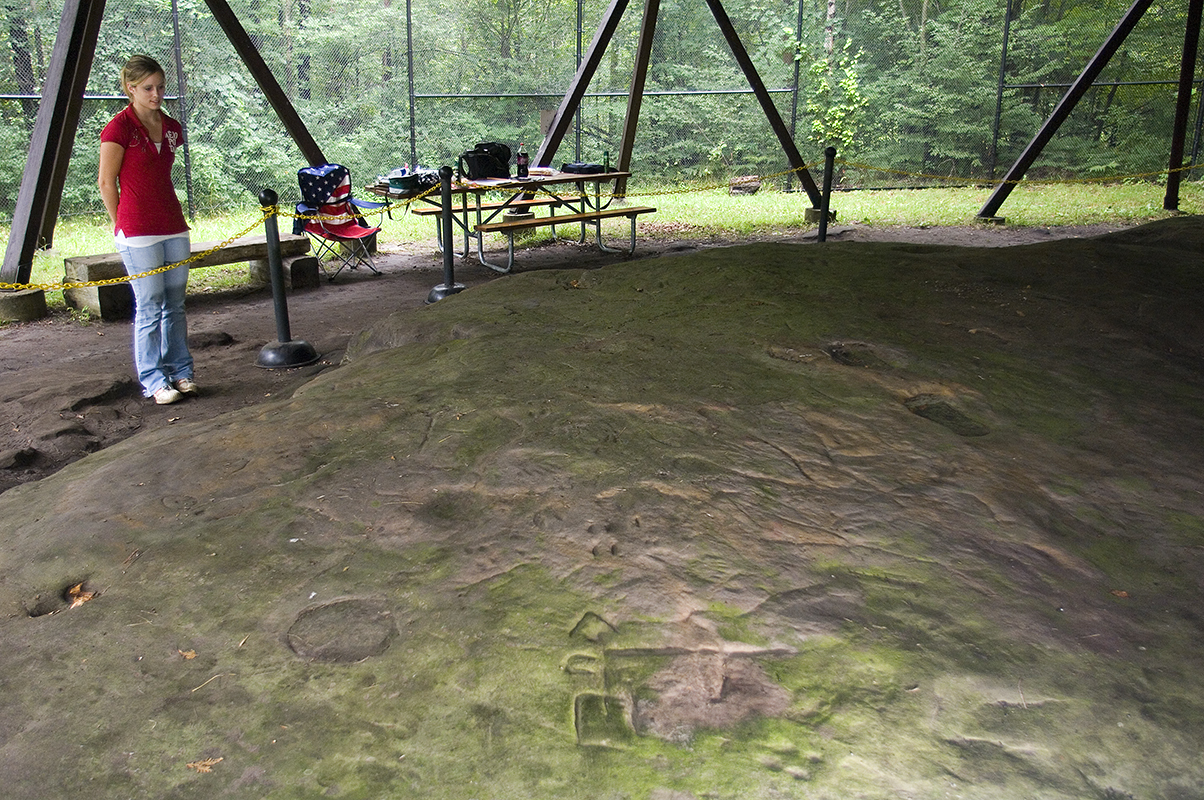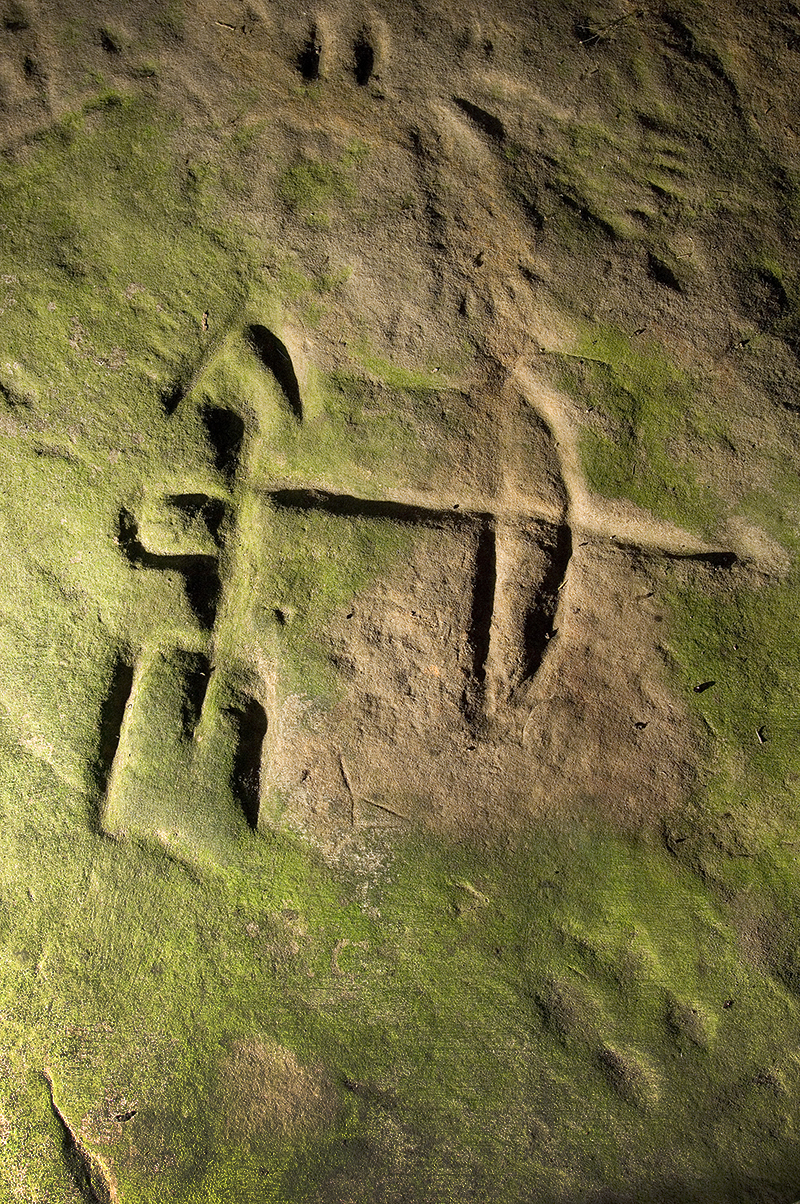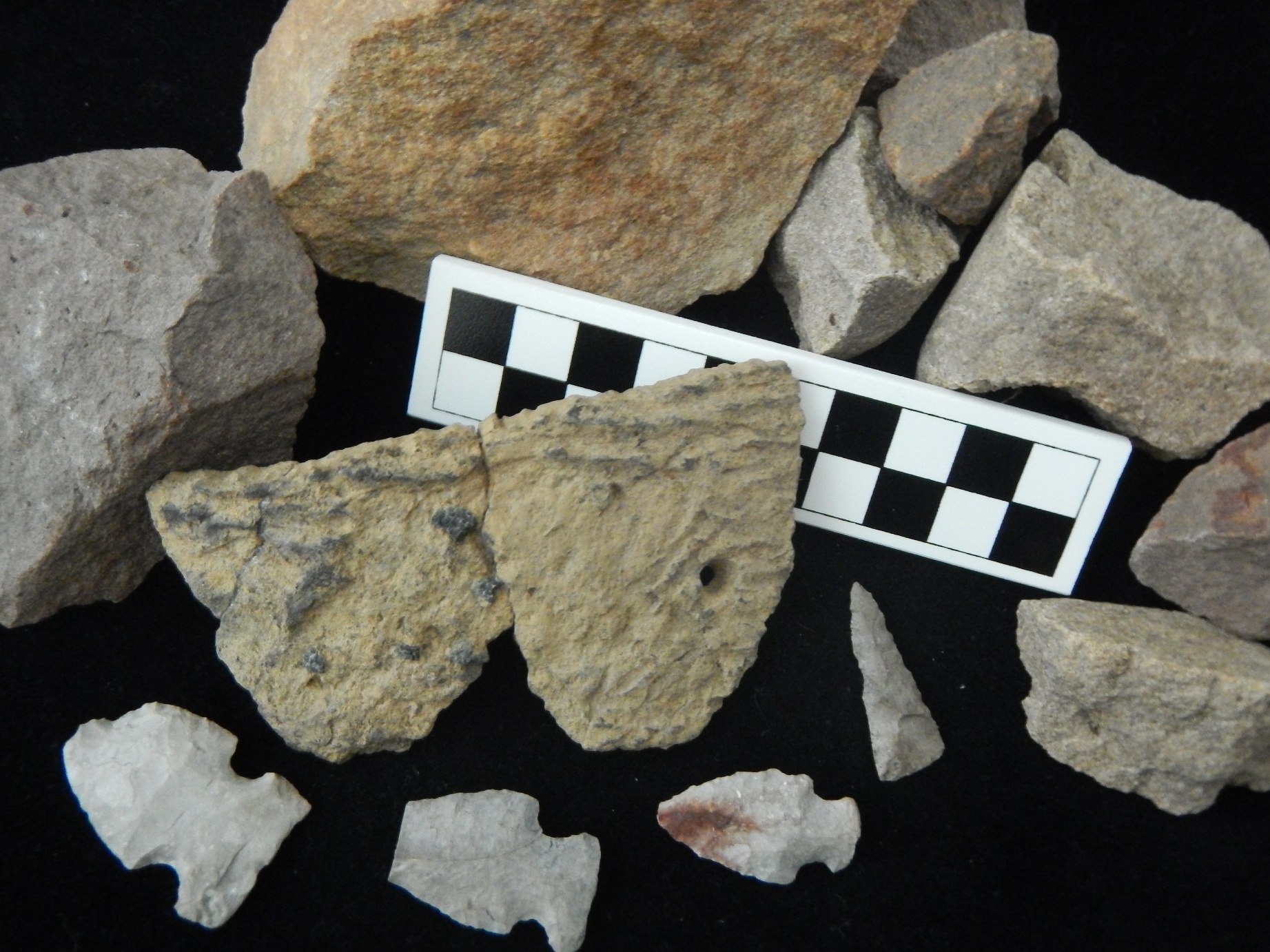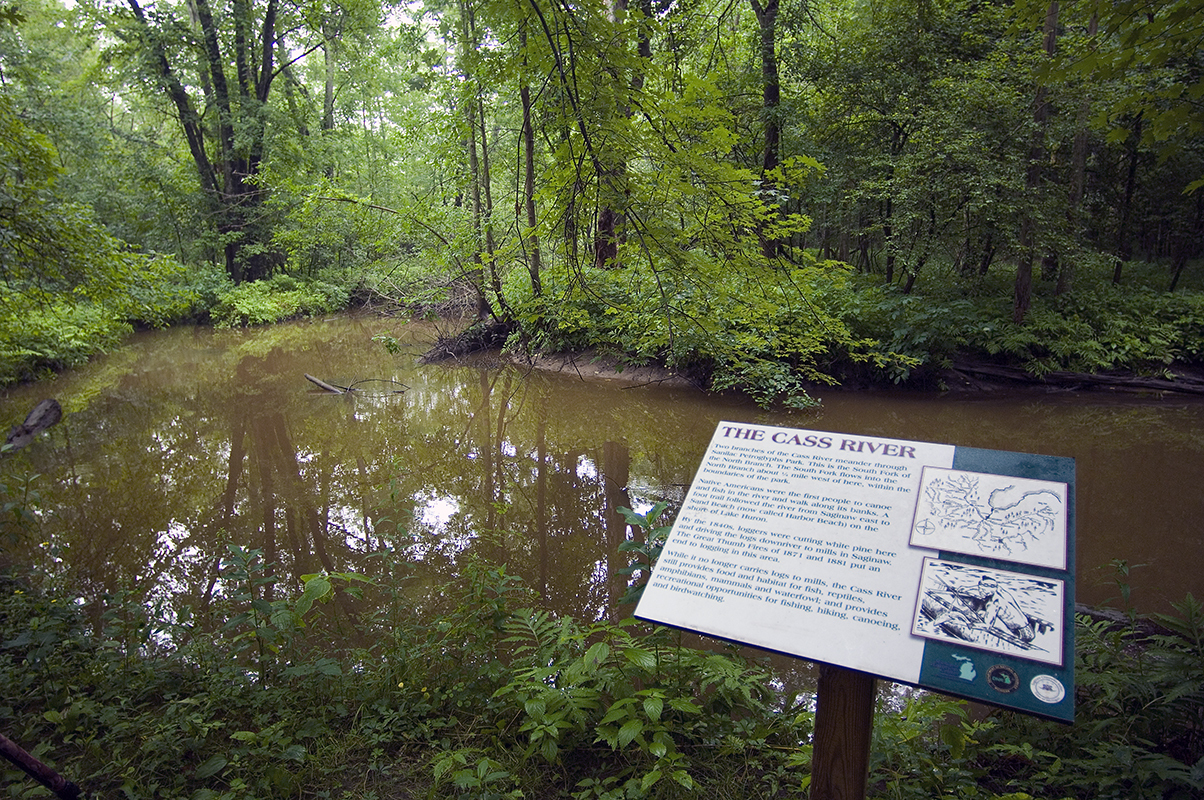Improvements at Sanilac Petroglyphs Historic State Park connect visitors with Native culture
When you think about all of the ways to enjoy the great outdoors in Michigan’s state parks, exploring ancient cultures and archaeology probably isn’t the first thing that comes to mind, but a unique state park Michigan’s Thumb gives residents and visitors an unusual opportunity to do just that.
Located in the northwestern corner of Sanilac County, on the Cass River floodplain, the 240-acre Sanilac Petroglyphs Historic State Park is one of the few sites of its kind in the Great Lakes Region.
Petroglyphs are carvings on rock, in this case, made by people who lived in the area long before Europeans arrived.
Significant site
 The park features an outcropping of Marshall sandstone with more than 100 petroglyphs carved into its surface by Native people. The site represents the most extensive group of petroglyphs known in Michigan and is listed on the National Register of Historic Places. The park features an outcropping of Marshall sandstone with more than 100 petroglyphs carved into its surface by Native people. The site represents the most extensive group of petroglyphs known in Michigan and is listed on the National Register of Historic Places.
The petroglyphs were rediscovered after an 1881 wildfire devastated much of the region and burned off the vegetation that had covered the sandstone outcropping.
In 1966, the Michigan Archaeological Society bought the site, which until then was part of a privately owned farm.
Five years later, the society conditionally deeded the land to the state, requiring the site be protected and remain open for nonprofit public education.
“It is preserved thanks to the actions of the Michigan Archaeological Society and interpreted thanks to our partnership with the Saginaw Chippewa Indian Tribe,” said Sandra Clark, director of the Michigan History Center. “As that partnership deepens, we hope to expand opportunities for visitors to experience Native culture here.”
Cultural relevance
Along with other Anishinaabeg of the Great Lakes Region, the Saginaw Chippewa Indian Tribe of Michigan celebrates a long-standing connection to the Sanilac Petroglyphs, which are located within its historic territory. Tribe of Michigan celebrates a long-standing connection to the Sanilac Petroglyphs, which are located within its historic territory.
In the Anishinaabemowin language, the petrogylphs site is called ezhibiigaadek asin or “written on stone.” For many tribal members, it is a sacred place, holding important teachings to be shared across generations.
Since 2001, intertribal cultural teachings, feasts, rituals and other events, some of which are open to public participation, have been held at the park.
Partnership
In 2015, the State Historic Preservation Office partnered with the Michigan History Center, the Michigan Department of Natural Resources' Parks and Recreation Division, the Saginaw Chippewa Indian Tribe of Michigan and the Ziibiwing Center of Anishinabe Culture & Lifeways to seek grants for improvements at the park.
The petroglyphs are closely tied to the surrounding Cass River floodplain, and the partners are taking a holistic approach to parkwide management that connects cultural, social and natural features.
“Many dedicated individuals and organizations have been working collaboratively to educate the public about the ezhibiigaadek asin or Sanilac Petroglyphs,” said William Johnson, cultural resource management curator at the Ziibiwing Center. “Raising awareness is imperative to protecting and preserving this sacred site and way of life.”
In the past year, the partners have been awarded a total of $45,000 from the Cultural Resources Fund. The fund was established by the Federal Trade Commission and seven Class 1 freight rail companies to support tribal and state cultural and historic preservation projects.
 The funds will be used toward site documentation and preservation, updated interpretation and new park trail bridges. Visitors to the park this summer will see the first stage of the grant-funded work in the form of new interpretative signs co-authored by tribal and state historians. The funds will be used toward site documentation and preservation, updated interpretation and new park trail bridges. Visitors to the park this summer will see the first stage of the grant-funded work in the form of new interpretative signs co-authored by tribal and state historians.
“I’m pleased with the recent improvements to the interpretive signage. Our beautiful language resounds within the text and the traditional beliefs of the Anishinabe are presented in an enlightening and respectful manner,” Johnson said. “I consider this a gift to the world, and it makes me happy knowing that everyone has worked so hard and that I’m a small part of it all.”
The Ziibiwing Center of Anishinabe Culture & Lifeways hosts an annual Summer Solstice community cultural teaching, cleansing and feast at Sanilac Petroglyphs, where intertribal representatives share their language, music and some lessons exhibited in the carvings.
The public is encouraged to participate. This year, the event will take place Saturday June 25. For more information, visit the Ziibiwing Center website.
Archaeological significance
Archaeologists from a variety of organizations have studied the Sanilac Petroglyphs since the 1920s, recording the carvings through drawings, photographs and plaster casts and excavating in the area around the rock outcrop. the 1920s, recording the carvings through drawings, photographs and plaster casts and excavating in the area around the rock outcrop.
“In a way that is perhaps somewhat different from other archaeological sites, the Sanilac Petroglyphs offer a glimpse into the past, and through the images carved there, give us a chance to connect with the people who created them,” said Dean Anderson, state archaeologist of Michigan.
Stone tools and pottery found during investigations indicate that Native people occupied the area intermittently over the last 5,000 years. These artifacts help broadly date the creation of the carvings to within the last 1,500 years.
A prominent carving featuring a bow and arrow also suggests the petroglyphs originated within this time period, following the introduction of that technology.
Archaeologists, observing that artifacts are sparse at the site, think that Native people did not establish a permanent village or camp at this location. More likely, this was a special place that small groups of people visited occasionally for brief periods of time.
“Future research, using new technologies, may teach us more than we know today,” said Stacy Tchorzynski, State Historic Preservation Office and DNR staff archaeologist. “This is  one reason why preserving archaeological sites is so important.” one reason why preserving archaeological sites is so important.”
Floodplain
In addition to the rock carvings, Sanilac Petroglyphs Historic State Park offers the chance to explore the lush floodplain forest and observe its diverse plants and animals.
A mile-long hiking trail crosses the Cass River in two places and the adjacent woodland is home to a wide variety of birds. Signs placed along the trail introduce visitors to points of natural and cultural interest.
The trail is open from 8 a.m. to 10 p.m. year-round.
Stewardship
Because of its importance as an archaeological preserve and a sacred site for today’s tribal communities, visitors are asked to be good stewards of the site.
“I admire this incredible place for its enduring craftsmanship, the continuing relevance of its environmental and cultural lessons and its powerful ability to connect people in thoughtful and thought-provoking ways,” Tchorzynski said. “Park visitors play a huge role in helping to protect the site for future generations.”
If you visit the park, be sure to stay on designated trails, investigate only with your eyes, respect historic features and leave any artifacts that you may find in place.
The carvings in soft sandstone are easily damaged by rain, wind, frost, plants, animals (including roving pets) and the abrasion and oils from human touch.
Located at 8251 Germania Road near Cass City in Greenleaf Township, the Sanilac Petroglyphs historic site is open for guided viewing 10 a.m. to 5 p.m., Wednesday through Sunday, Memorial Day through Labor Day (please call ahead at 989-856-4411 to confirm hours and dates). Admission is free.
Sanilac Petroglyphs Historic State Park is jointly operated by the Michigan History Center – an agency within the Michigan Department of Natural Resources – and the DNR’s Parks and Recreation Division.
Learn more about the Sanilac Petroglyphs.
Catch upcoming stories by subscribing to free, weekly “Showcasing the DNR” articles. Check out previous articles.
/Note to editors: Contact: Maria Quinlan Leiby, 517-373-1685 or John Pepin, 906-226-1352. Accompanying photos are available below for download. Suggested captions follow. Credit: Michigan Department of Natural Resources.
Archer (DSK339_46): Ebmodaakowet, the archer seen carved here, is shooting the knowledge carved into the stone seven generations into the future.
Artifacts: Artifacts recovered at the Sanilac Petroglyphs Historic State Park, including fire-cracked rock from hearths, refitted pieces of decorated pottery and stone projectile points.
River (DSK339_09): An interpretive sign is shown along the banks of the Cass River at Sanilac Petroglyphs Historic State Park in Sanilac County.
Visitor (DSK339_50): A visitor views petroglyphs at Sanilac Petroglyphs Historic State Park in the Lower Peninsula.
Map: Inverse image of map of the Sanilac Petroglyphs crafted by Darrel J. Richards, circa 1940.
Additional photos: Sandra Clark./
The Michigan Department of Natural Resources is committed to the conservation, protection, management, use and enjoyment of the state’s natural and cultural resources for current and future generations. For more information, go to www.michigan.gov/dnr.
|

 The park features an outcropping of Marshall sandstone with more than 100 petroglyphs carved into its surface by Native people. The site represents the most extensive group of petroglyphs known in Michigan and is listed on the National Register of Historic Places.
The park features an outcropping of Marshall sandstone with more than 100 petroglyphs carved into its surface by Native people. The site represents the most extensive group of petroglyphs known in Michigan and is listed on the National Register of Historic Places. Tribe of Michigan celebrates a long-standing connection to the Sanilac Petroglyphs, which are located within its historic territory.
Tribe of Michigan celebrates a long-standing connection to the Sanilac Petroglyphs, which are located within its historic territory. The funds will be used toward site documentation and preservation, updated interpretation and new park trail bridges. Visitors to the park this summer will see the first stage of the grant-funded work in the form of new interpretative signs co-authored by tribal and state historians.
The funds will be used toward site documentation and preservation, updated interpretation and new park trail bridges. Visitors to the park this summer will see the first stage of the grant-funded work in the form of new interpretative signs co-authored by tribal and state historians. the 1920s, recording the carvings through drawings, photographs and plaster casts and excavating in the area around the rock outcrop.
the 1920s, recording the carvings through drawings, photographs and plaster casts and excavating in the area around the rock outcrop. one reason why preserving archaeological sites is so important.”
one reason why preserving archaeological sites is so important.”




